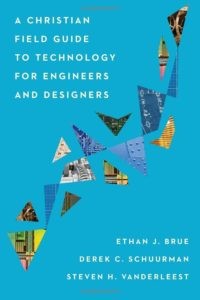This book, “A Christian Field Guide to Technology for Engineers and Designers” by Ethan J. Brue, Derek C. Schuurman, and Steven H. VanderLeest (IVP Academic, 2022), offers a compelling Christian perspective on the field of technology, specifically tailored for engineers and designers. It transcends its seemingly niche title to offer valuable insights for any Christian seeking to integrate their faith with their profession.
 Book cover featuring the title "A Christian Field Guide to Technology for Engineers and Designers" along with the authors' names and the IVP Academic logo.
Book cover featuring the title "A Christian Field Guide to Technology for Engineers and Designers" along with the authors' names and the IVP Academic logo.
Bridging Faith and Technology
The authors, all with extensive experience as engineering professors and in the industry, demonstrate a clear understanding of the challenges and opportunities faced by Christian engineers and designers. They address the yearning to design technology and argue that faith underlies all technological pursuits, both as designers and users.
The book’s ten chapters explore a range of topics, including the biblical story and its relevance to technology, responsibility in design, and ethical principles. Each chapter is clearly attributed to its author, providing diverse perspectives within a cohesive framework.
Navigating Ethical Landscapes
The book challenges the notion that professional ethics are sufficient for Christian engineers. As Schuurman notes, “Even though we are living within the story of Scripture, we can still make use and benefit from codes like the NSPE code of ethics. But these ethical codes, when seen within the biblical narrative, have a limited scope. For the Christian engineer, professional ethics are necessary but not sufficient. Our call as Christian engineers is far more comprehensive!” (102). This highlights the importance of a faith-informed ethical compass that goes beyond industry standards.
Combating Technological Idolatry
The authors confront the potential for technology to become an idol, shaping our worldviews and influencing our behavior in subtle ways. They explore the dangers of technicism and the need for critical reflection on the impact of technology on our lives. This is a crucial point not only for engineers and designers but also for Christians in any profession.
History, Progress, and the Future
Brue examines the history of electric vehicles to illustrate the complex factors influencing design choices and technological development. He emphasizes that progress must be biblically guided, reflecting the intended wholeness of creation.
Schuurman addresses both technological optimism (transhumanism) and pessimism, arguing that neither extreme provides a balanced perspective. He cautions against viewing technology as the primary solution to human problems, reminding us that the root of many issues lies within the human heart.
A Calling to Serve
VanderLeest argues that pursuing engineering and design is not mutually exclusive with serving God in the mission field. Technological work is a legitimate Christian calling, offering opportunities to serve neighbors, bear witness to coworkers, and contribute to cultural activities. “We find joy and delight in the creation of the tool” (178), he writes, while reminding us that this work is always connected to loving God and our neighbors.
Practical Application
The book concludes with a series of letters between a young engineer and his former teacher, providing a practical and engaging application of the book’s content to real-world industry settings. These letters illustrate how the issues discussed throughout the book come into play in everyday professional life.
Strengths and Weaknesses
One of the book’s main strengths is the authors’ deep understanding of the design and engineering industries, combined with their ability to connect theory to practice. The book is accessible to readers with little background knowledge, providing a clear and compelling introduction to the integration of faith and technology. The inclusion of chapter summaries and key definitions enhances its usefulness for students.
Some weaknesses include occasional inconsistencies in flow between chapters, reflecting the challenges of multiple authors contributing to a single work. The historical chapter on electric vehicles feels somewhat disconnected from the rest of the book. Additionally, some of the concrete suggestions, such as guiding design with “play” or aesthetic life, may lack practical applicability.
A Valuable Resource
Despite these minor weaknesses, “A Christian Field Guide to Technology for Engineers and Designers” remains a valuable resource for students and professionals in the field of technology. It provides a compelling vision for integrating faith with professional practice and encourages readers to approach technology with a critical and biblically informed perspective.
This book serves as an excellent example of integrating faith and learning in a way that goes beyond superficial applications. It is a resource that should be widely available to students in design and engineering programs.